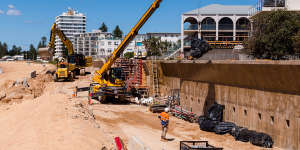The new authority on Friday released a report foreshadowing the annual cost of damage to homes,businesses and other infrastructure will surge from $3.1 billion to $9.1 billion by 2060,particularly from the growing threat of coastal inundation and erosion.

The break wall along Collaroy Beach was built in 2021 in response to severe storm erosion.James Brickwood
The NSW government revealed the worst-case scenarios in its inaugural State Disaster Mitigation Plan,under which it will partner with councils to better prepare and deal with increasing bushfires,heatwaves,floods,storms and coastal erosion. The authority said the plan would help deliver short- to medium-term mitigation infrastructure,as well as co-ordinate managed relocation and the creation of warning and evacuation systems.
Emergency Services Minister Jihad Dib said successive years of natural disasters,including the Black Summer fires and the 2022 floods,had highlighted the need to plan for climate threats.
“There is no easy or simple solution to these challenges. The focus of the plan is to provide a framework and clear actions for reducing risk where we can,and adapting where we can’t,through improved warning systems and a focus on resilient infrastructure,” he said.
“The increasing risk of natural disasters also increases pressure on our emergency services staff and volunteers,who put themselves on the line keeping communities safe.”

The plan will also help guide decisions on where to deliver new housing and infrastructure and where and how to invest in risk-reduction activities.
By 2060,coastal inundation and erosion will be the primary drivers of natural disaster damage,the authority said. The Northern Beaches and Central Coast local government areas are likely to experience the greatest loss to built environments,averaging an annual loss of $867 million and $426 million per year under a worse-case-scenario model.
Northern Beaches Mayor Sue Heins said her area had experienced a range of extreme weather events over the past few years,but had allowed the community to enhance its capacity to prepare for,respond to and recover from natural disasters.

“Like all councils,we face the balancing act of appropriately managing development in areas at risk of natural hazards now and into the future while also managing the supply of affordable housing for current and future generations,” she said. “We need to ensure that planning frameworks and controls incorporate the best available technical and local knowledge to navigate this challenge.”
While the council had not seen the final copy of the plan before its public release on Friday,Heins said they would review the details and continue to work with the government and community to ensure the northern beaches were prepared and resilient to climate change and natural disasters.
The council is investing heavily in flood and storm protection works along the Collaroy-Narrabeen beach and Narrabeen Lagoon,as well as national parks and bushland reserves that pose bushfire risks.
However,the greatest problem many councils and communities will face is compounding natural disasters. Since 2019,NSW residents have endured over 65 declared disasters,often overlapping,costing taxpayers more than $6 billion,with more than 20,000 homes damaged in 2022 alone.
Wet weather in Sydney has forced the M5 motorway to close,causing chaos for commuters.
From 1967 to 2022,the most expensive natural disasters were hailstorms,accounting for $23 billion in total losses,while storms accounted for $10 billion,fires were $3.8 billion and earthquakes were $6 billion.
Why is Australia so disaster-ridden?
Professor Mark Howden,from the Australian National University’s Institute for Climate,Energy and Disaster Solutions,said Australia was heavily exposed to climate-related risks and often many of them occur one after the other,or at the same time.
Howden gave the example of a drought,which usually overlaps with a heatwave,a bushfire and smoke-related health issues.
“In the past,Australia has had a strong focus on recovery from extreme events rather than focusing on prevention of extreme events. But we are starting to think about how to limit our exposure to these extreme events rather than cleaning up,” he said.

The Black Summer fires had been a key driver in this shift,as well as a long-term international focus on the area,he said. As more countries focus on mitigation and preparedness,no nation has quite mastered it.
Climate change is making it trickier to prepare,and disaster after disaster is stressing resources,Howden said.
Four people died and hundreds of properties were destroyed when four raging fire fronts combined to devastate Canberra in 2003.
“With climate change,the goal posts keep on changing. They are closer together so kicking goals – or having a successful response to a natural disaster – is getting harder and harder. The evolution of extreme weather events is not what we could have predicted was going to happen in the 2020s.
“Globally,a. There is a real prospect that people will be stumbling from one disaster to the next,with resources getting more depleted.”
Planning and Public Spaces Minister Paul Scully said historically the state’s ability to prevent and prepare for disasters had not worked,with 3 per cent of funding spent on prevention,and the majority spent on recovery.
“But we know that every dollar we invest in better preparing communities reduces future costs and will help make communities more resilient,” he said.
“The cost of inaction is too great:we need to better prepare and plan for disasters so we can lessen the burden on our communities. It gives us the tools we need to make better,more informed decisions about planning,so we can deliver more resilient homes away from areas of high risk.”

Planning Minister Paul Scully.Dion Georgopoulos
Committee for Sydney said resilience program director Sam Kernaghan said Sydney had experienced 12 natural disasters in the past four years,so the time for action was now.
“We are especially pleased to see a plan for managed relocation and steps to align insurance data with planning decisions to avoid future communities being uninsurable against flooding and other disasters,” he said.
